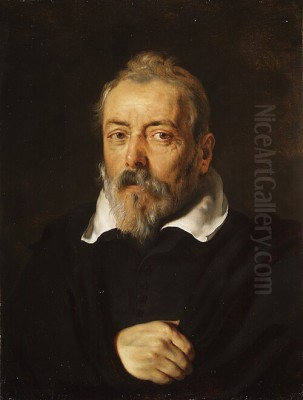
Frans Francken the Elder, born in Herentals around 1542 and deceased in Antwerp on October 6, 1616, stands as a pivotal figure in the rich tapestry of Flemish art. He was a prominent member of the extensive Francken family of painters, a dynasty that significantly shaped the artistic landscape of Antwerp throughout the 16th and 17th centuries. His career bridged the late Mannerist period and the burgeoning Baroque style, making his work a fascinating study of artistic transition and enduring quality.
A Life Steeped in Art: The Biography of Frans Francken I
Frans Francken I, often referred to as Frans Francken the Elder to distinguish him from his equally, if not more, famous son Frans Francken the Younger, was born into an artistic milieu. His father, Nicolaes Francken, also a painter from Herentals, likely provided his initial instruction in the rudiments of art. However, the most significant formative influence on the young Frans was his apprenticeship under the leading Antwerp history painter, Frans Floris. Floris, who had studied in Italy and absorbed the lessons of Michelangelo and Tintoretto, was a central figure in introducing Romanism – an Italian-influenced Renaissance style – to the Southern Netherlands.
This training under Floris, which likely occurred in the late 1550s or early 1560s, was crucial. Floris's studio was a bustling hub, attracting ambitious young artists, and it was here that Francken would have honed his skills in figure drawing, composition, and the grand manner of history painting. By 1567, Frans Francken I had become a master in the Antwerp Guild of Saint Luke, the city's venerable institution for painters, sculptors, and other craftsmen. This membership was a prerequisite for establishing an independent workshop and taking on pupils.
In 1573, Frans married Elisabeth Mertens. The couple had a large family, and significantly, several of their sons followed in their father's footsteps, becoming accomplished painters themselves. These included Thomas Francken, Hieronymus Francken I (who later worked extensively in France), Frans Francken II (the Younger), and Ambrosius Francken II. Hieronymus I and Frans II, in particular, achieved considerable fame, with Frans the Younger becoming especially known for his small-scale cabinet pictures, allegories, and "gallery paintings."
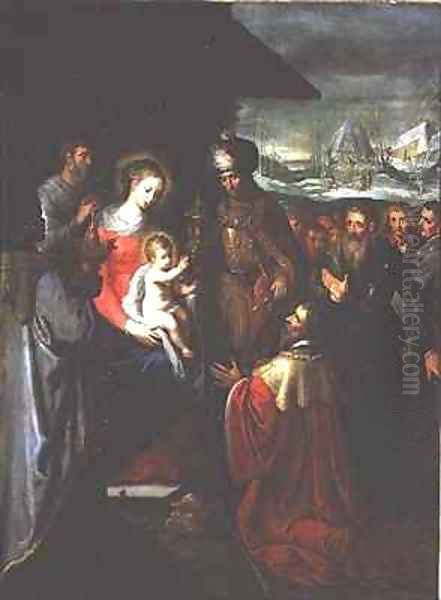
Frans Francken the Elder maintained an active and successful workshop in Antwerp for many decades. He received numerous commissions, primarily for altarpieces and other religious subjects, reflecting the resurgence of Catholic patronage following the iconoclastic troubles (Beeldenstorm) of 1566 and the subsequent Counter-Reformation efforts. He served as deacon of the Guild of Saint Luke in 1587, a testament to his respected position within the artistic community. His career spanned a period of significant political and religious upheaval in the Southern Netherlands, yet he managed to sustain a productive output until his death in Antwerp in 1616.
Artistic Flourish: Style and Technique
Frans Francken the Elder's artistic style is characteristic of the late 16th-century Antwerp school, deeply rooted in the Mannerist tradition inherited from his master, Frans Floris, but also showing a gradual evolution towards a more robust and dynamic approach that prefigured the Baroque. His works often feature complex, multi-figured compositions, a hallmark of Mannerism. Figures tend to be elongated, with elegant, sometimes contorted, poses – the figura serpentinata being a common device.
His palette was typically rich and varied, often employing vibrant, jewel-like colors that lent a decorative quality to his paintings. He demonstrated a keen attention to detail, particularly in the rendering of fabrics, armor, and architectural elements. While his early works more closely reflect the muscular, heroic style of Floris, his later paintings exhibit a somewhat softer modeling and a greater interest in narrative clarity. He often worked on a large scale, producing altarpieces for churches in Antwerp and beyond, but he also created smaller cabinet pieces.
Francken's technique was meticulous. He primarily painted in oil on panel, a common practice in Northern Europe, though copper was also used for smaller, more refined works. His brushwork, while precise, could also be quite fluid, especially in his depiction of drapery. He was adept at conveying a sense of drama and emotion, particularly in his religious scenes, which often depicted moments of intense pathos or divine revelation. The influence of Venetian painters, such as Titian and Tintoretto, can be discerned, likely transmitted through Floris and the general artistic exchange between Italy and Flanders.
A notable characteristic of his compositions is their often crowded nature, filled with numerous figures engaged in various activities. This allowed him to showcase his skill in depicting diverse human types and expressions. While sometimes criticized for a certain stiffness in his figures compared to the dynamism of later Baroque masters like Peter Paul Rubens, Francken's work possesses a distinct charm and a strong narrative drive. He was also known to occasionally collaborate with other artists, a common practice in Antwerp, though specific collaborations are sometimes difficult to pinpoint definitively for him compared to his sons.
Masterpieces of an Era: Notable Works
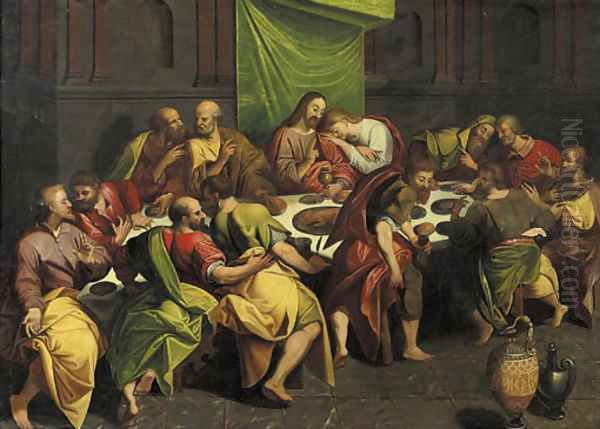
Frans Francken the Elder produced a significant body of work, primarily religious and mythological subjects. While attribution can sometimes be complex due to the many painting members of the Francken family, several key works are firmly associated with him and exemplify his style.
One of his most important and well-documented commissions is the Triptych of the Crucifixion with Donors and Saints Peter and Paul (also known as the Rockox Triptych), created around 1590-1600 for the epitaph of Adriaan Rockox and Catherina van Overhoff in the church of the Friars Minor in Antwerp (now in the Royal Museum of Fine Arts Antwerp). This large altarpiece showcases his ability to manage a complex composition with numerous figures, including a dramatic central Crucifixion scene flanked by donor portraits and saints. The detailed rendering of the figures and the rich coloration are typical of his mature style.
Another significant work is Christ among the Scribes and Pharisees (circa 1587, Antwerp Cathedral). This painting, originally part of a triptych for the guild of schoolmasters, demonstrates his skill in depicting animated discussion and varied human reactions. The central figure of the young Christ is serene amidst the agitated scholars, a common iconographic trope handled with Francken's characteristic attention to individual expression.
The Adoration of the Magi was a theme he returned to multiple times, allowing for a display of exotic figures, rich costumes, and a sense of pageantry. Examples can be found in various collections, each showcasing his ability to create a bustling, celebratory scene filled with intricate details. Similarly, The Last Supper was another biblical subject he depicted, often emphasizing the solemnity and emotional gravity of the moment.
His Allegory of Opportunity (Occasio), also known as Time Reveals Truth, is an interesting example of his engagement with allegorical themes, popular during the Renaissance and Mannerist periods. These works often carried complex moral or philosophical messages, conveyed through symbolic figures and attributes.
Other representative works include:
The Parable of the Prodigal Son: A subject that allowed for narrative development across different scenes, often depicted within a single composition or as part of a series.
Christ Carrying the Cross: These scenes are typically filled with a multitude of figures, capturing the drama and pathos of the event. An example is the one in the National Museum in Warsaw.
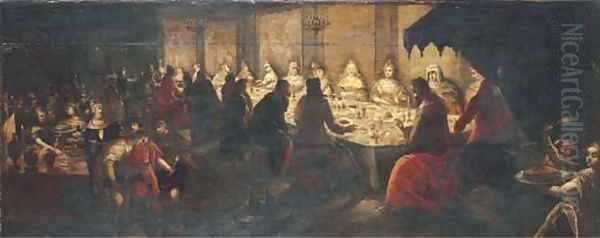
The Last Judgment: A popular theme for large-scale works, allowing for dramatic depictions of heaven, hell, and the resurrection of the dead.
Scenes from the Life of Esther: Biblical heroines were also a source of inspiration.
Many of his works are found in major European museums, including the Royal Museum of Fine Arts in Antwerp, the Prado Museum in Madrid, the Kunsthistorisches Museum in Vienna, and the Hermitage Museum in St. Petersburg, attesting to his contemporary reputation and the subsequent dispersal of his art.
A Network of Talent: Contemporaries and Collaborations
Frans Francken the Elder operated within a vibrant and competitive artistic environment in Antwerp, which was one of Europe's leading art centers during his lifetime. His primary artistic lineage traces back to Frans Floris (c. 1519/20 – 1570), his teacher, who was a dominant figure in Antwerp painting in the mid-16th century. Floris's studio was a veritable academy, producing a generation of artists who disseminated his Italianate style.
Among Francken's direct contemporaries and fellow pupils of Floris were artists like Crispijn van den Broeck (1523–c. 1591) and Marten de Vos (1532–1603). De Vos, in particular, became a leading history painter in Antwerp after Floris's death and was a prolific designer of prints. Francken's style shares certain affinities with de Vos, especially in their shared Mannerist vocabulary and their focus on religious commissions for the Counter-Reformation.
His own brother, Ambrosius Francken I (c. 1544–1618), was also a significant painter, working in a similar style and often tackling comparable religious and allegorical themes. The two brothers would have shared influences and likely competed for commissions, though their relationship seems to have been amicable. Another brother, Hieronymus Francken I (c. 1540–1610), also trained with Floris and later established a successful career at the French court in Paris and Fontainebleau, contributing to the spread of Flemish Mannerism abroad.
The generation that followed Francken the Elder included some of the towering figures of Flemish Baroque. While Peter Paul Rubens (1577–1640) was younger and ushered in a dramatically different, more dynamic Baroque style, he would have been aware of the established masters like Francken. Rubens's own teacher, Otto van Veen (c. 1556–1629), was a contemporary of Francken and also a prominent history painter with a classicizing, Romanist bent.
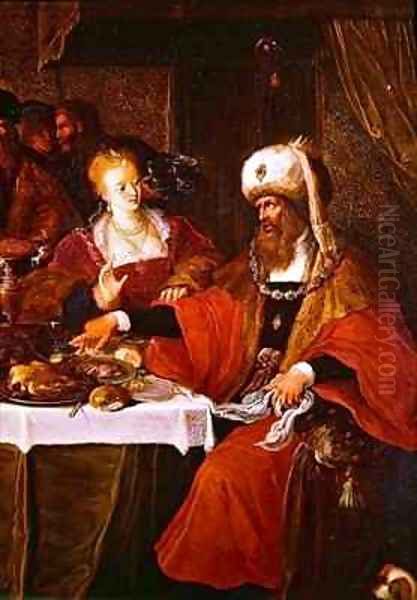
Other notable Antwerp painters active during Francken's career include Adam van Noort (1561/2–1641), who was a teacher to both Rubens and Jacob Jordaens, and landscape specialists like Joos de Momper (1564–1635) and Jan Brueghel the Elder (1568–1625). While direct collaborations between Frans Francken I and these landscape or genre specialists are not as extensively documented as they are for his son Frans II, the collaborative workshop environment was a defining feature of Antwerp's art scene. It's plausible that figures in landscapes or staffage in architectural paintings by specialists were sometimes added by history painters like Francken, or vice versa.
Of course, his most significant artistic "collaborators" in a broader sense were his sons, particularly Frans Francken II (the Younger) (1581–1642), Hieronymus Francken II (1578–1623), and Ambrosius Francken II (c. 1590–1632). They inherited his workshop traditions and stylistic tendencies, with Frans the Younger especially developing a highly successful career, popularizing new genres like the Kunstkammer or gallery painting. The stylistic similarities between the father and his sons, especially in their early careers, can make attributions challenging. The Francken dynasty also included painters like Constantijn Francken and later descendants, ensuring the family name remained prominent in Antwerp art for over a century. The influence of Italian masters like Tintoretto, Veronese, and even earlier figures like Raphael continued to resonate in Antwerp, often filtered through the interpretations of artists like Floris and his followers, including Francken the Elder.
The Enduring Legacy: Market Presence and Art Historical Standing
Frans Francken the Elder's works, like those of many Old Masters, appear on the art market with some regularity, though less frequently than those of his more prolific son, Frans Francken the Younger. When his paintings come up for auction, they generally command respectable prices, particularly well-preserved, securely attributed pieces with good provenance. Large-scale altarpieces or significant religious compositions tend to achieve higher values than smaller, more generic works.
The market for Francken the Elder's art is influenced by several factors. Attribution is key; the sheer number of painters in the Francken family means that works are sometimes misattributed between Frans I, Frans II, Ambrosius I, and other relatives. Scholarly consensus and scientific analysis can play a role in firming up attributions. Condition is also paramount, as many Old Master paintings have undergone restoration or suffered damage over the centuries. The subject matter can influence desirability, with complex biblical narratives or striking allegories often being more sought after.
Compared to the superstars of Flemish painting like Rubens, Van Dyck, or even Jan Brueghel the Elder, Frans Francken I's prices are more moderate. However, he is recognized as a significant and skilled master of his time. His works are acquired by private collectors and public institutions keen on representing the breadth of Flemish painting from the late 16th century. The art historical appreciation for Mannerist art has also grown, leading to a better understanding and valuation of artists like Francken who excelled in this style.
In terms of his art historical position, Frans Francken the Elder is regarded as a key figure in the Antwerp school during the latter half of the 16th century. He successfully navigated the transition from the High Renaissance ideals promoted by his teacher Frans Floris to a more distinctly Mannerist aesthetic, while also laying some groundwork for the dynamism that would characterize the subsequent Baroque era. He was a master of the multi-figured religious composition, fulfilling the needs of the Counter-Reformation Church for didactic and devotional imagery.
His primary importance, beyond his individual artistic achievements, lies in his role as the patriarch of an exceptionally productive and influential artistic dynasty. The Francken workshop became a powerhouse, and his sons, particularly Frans the Younger, built upon his legacy to achieve even wider fame and influence. Frans the Elder's contribution was to establish a high standard of craftsmanship and a versatile approach to subject matter that his descendants would continue and adapt. He represents a crucial link in the chain of artistic development in Antwerp, a city that was a crucible of innovation in European art.
Anecdotes and the Francken Dynasty
Specific, colorful anecdotes about Frans Francken the Elder's personal life are somewhat scarce, as is often the case for artists of this period unless they achieved the level of fame that invited contemporary biographers like Karel van Mander to record such details extensively. Van Mander does mention him in his Schilder-boeck (Book of Painters) of 1604, noting him as one of Frans Floris's many pupils and a good painter active in Antwerp.
However, the "anecdote" of the Francken family itself is perhaps the most compelling story. The sheer number of successful painters emerging from one lineage is remarkable. This phenomenon speaks to the workshop system of the time, where artistic skills were passed down from father to son, and family members often collaborated or specialized in different aspects of painting. The Francken workshop, under Frans I and later his sons, must have been a highly organized and productive enterprise.
One can imagine the bustling environment, with apprentices grinding pigments, preparing panels, and learning the fundamentals, while the master and his advanced sons worked on commissions. The continuity of the family name in the records of the Guild of Saint Luke for generations is a testament to their collective success and dedication to the craft. This dynastic aspect also led to complexities in attribution, as styles could be similar, and workshop productions often involved multiple hands. The "Francken style" became recognizable, characterized by elegant figures, rich colors, and often crowded, detailed compositions.
The success of his sons, especially Frans II, who became renowned for his innovative cabinet pictures, allegories, and depictions of art collections (Kunstkammer paintings), indirectly reflects on the solid foundation provided by their father. Frans II often signed his works "de jonge" (the younger) to distinguish himself from his father, and later, when his own son Frans III became a painter, Frans II signed "de oude" (the elder), adding another layer to the family's nomenclature. This conscious effort to differentiate themselves highlights the prominence of the family name in the art world.
Frans Francken the Elder's legacy, therefore, is not just in his own canvases but in the artistic dynasty he founded. He was a respected master, a pillar of the Antwerp artistic community, and a crucial figure in maintaining the city's reputation as a center of artistic excellence during a challenging period of religious and political turmoil. His contribution was foundational, providing both the artistic training and the established workshop that allowed the Francken name to flourish for generations.